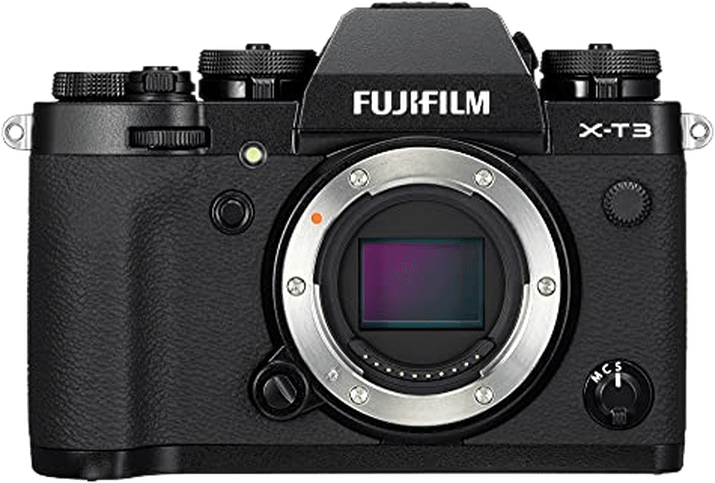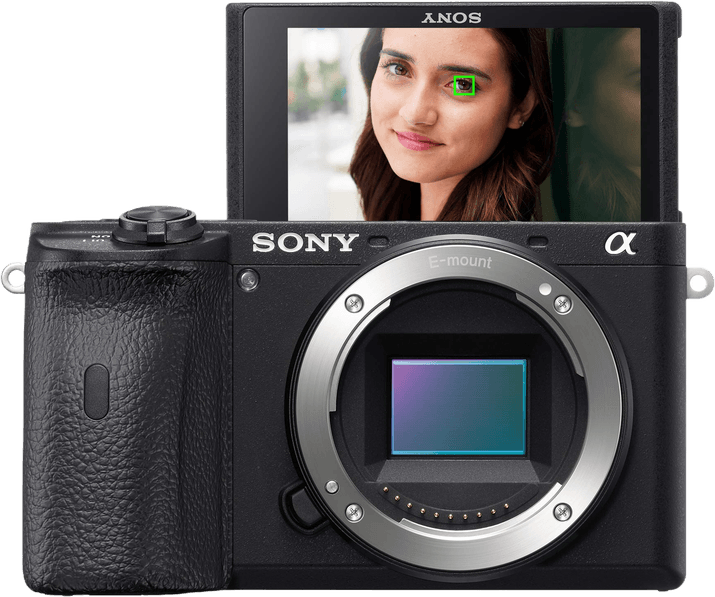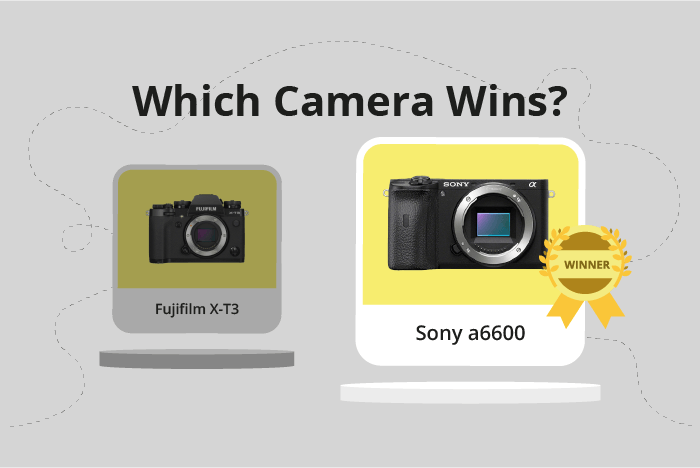Fujifilm X-T3 vs Sony a6600 Comparison
Fujifilm X-T3

Sony a6600

The Sony a6600 takes the lead with a score of 75/100, while the Fujifilm X-T3 trails slightly behind at 72/100. Both cameras are mirrorless and share similar dimensions, with the X-T3 measuring 133 x 93 x 59mm and the a6600 at 120 x 67 x 69mm. The a6600 is also lighter at 503g, compared to the X-T3’s 539g.
The Sony a6600 outperforms the Fujifilm X-T3 with its higher score, reflecting its better overall performance. However, the X-T3 has its advantages, such as a lower launch price of $539 compared to the a6600’s $1200.
Taking all factors into account, the Sony a6600 is the better camera, but the Fujifilm X-T3 can still be a good choice for those on a budget.
Fujifilm X-T3 vs Sony a6600 Overview and Optics
The Sony a6600 emerges as the winner in the optics comparison with a score of 76/100, while the Fujifilm X-T3 garners a score of 67/100. Both cameras possess certain common features, such as CMOS sensors, APS-C sensor sizes, and similar megapixel counts (26MP for the X-T3 and 24.2MP for the a6600). Additionally, both cameras use their respective proprietary lens mounts – Fujifilm X for the X-T3 and Sony E for the a6600.
The Sony a6600 outshines the Fujifilm X-T3 in a few aspects. First, it is equipped with image stabilization, which the X-T3 lacks. This feature enables the a6600 to capture steadier and sharper images, particularly in low light conditions or during handheld shooting. Second, the a6600’s sensor has a DXOMARK score of 82, indicating its superior image quality. However, it is important to note that DXOMARK does not score Fujifilm cameras, so a direct comparison is not possible.
On the other hand, the Fujifilm X-T3 boasts a higher shooting speed of 20 frames per second, compared to the a6600’s 11 frames per second. This makes the X-T3 a more suitable choice for capturing fast-moving subjects or action photography.
Taking these factors into account, the Sony a6600 proves to be a more versatile and reliable camera in terms of optics, particularly due to its image stabilization and superior sensor quality. However, for those prioritizing fast shooting speed, the Fujifilm X-T3 remains a strong contender. Ultimately, the choice between these two cameras depends on the specific needs and preferences of the photographer.
Fujifilm X-T3 vs Sony a6600 Video Performance
The Sony a6600 triumphs over the Fujifilm X-T3 in video capabilities, scoring 91/100 compared to the X-T3’s 83/100. Both cameras share common features, such as 4K max video resolution and built-in time-lapse functionality. However, there are key differences that make the a6600 a superior choice for video.
The Sony a6600 has a higher max video frame rate of 100fps, while the Fujifilm X-T3 maxes out at 60fps. This advantage allows the a6600 to capture smoother slow-motion footage, providing more flexibility for video creators. Additionally, the a6600 has a slightly smaller max video dimensions of 3840 x 2160, in comparison to the X-T3’s 4096 x 2160. This difference is minimal and should not impact the overall video quality significantly.
On the other hand, the Fujifilm X-T3 has a larger max video dimensions, which may appeal to some filmmakers who prefer the wider aspect ratio. However, this advantage is not enough to outweigh the benefits of the Sony a6600’s higher video frame rate.
Given these points, the Sony a6600 stands out as the better choice for video capabilities, offering smoother slow-motion footage and similar video quality to the Fujifilm X-T3. The Fujifilm X-T3’s marginally larger max video dimensions do not make up for its lower video frame rate. Therefore, the Sony a6600 is the recommended option for those prioritizing video performance in their camera selection.
Fujifilm X-T3 vs Sony a6600 Features and Benefits
The Fujifilm X-T3 outperforms the Sony a6600 with a feature score of 83/100, compared to the latter’s 81/100. Both cameras share several specifications, including a 3-inch screen size, touchscreen capabilities, flip screen, GPS absence, Wi-Fi, and Bluetooth connectivity.
The Fujifilm X-T3 excels with its higher screen resolution of 1,040,000 dots, providing a clearer and more detailed display for users. This advantage enables photographers to better review their shots and navigate the camera’s settings. Additionally, the X-T3’s two-point lead in the feature score indicates that it offers a more comprehensive set of features, making it a more versatile option for various photography needs.
On the other hand, the Sony a6600 has a slightly lower screen resolution at 921,600 dots. However, it still offers a competitive set of features that are on par with the Fujifilm X-T3 in most aspects, such as touchscreen, flip screen, Wi-Fi, and Bluetooth connectivity. The two-point difference in feature score is minimal, and the a6600 remains a strong contender in the market.
Considering each camera’s strengths and weaknesses, the Fujifilm X-T3 leads with its higher feature score and screen resolution, making it a preferable choice for more demanding photographers. The Sony a6600, while slightly trailing behind, still presents a competitive option for those seeking a well-rounded camera with a nearly identical set of features to the X-T3. Ultimately, the choice between these two cameras depends on the individual’s photography needs and preferences.
Fujifilm X-T3 vs Sony a6600 Storage and Battery
The Fujifilm X-T3 outperforms the Sony a6600 in storage and battery, scoring 68/100 compared to the Sony’s 48/100. Both cameras accept SD, SDHC, and SDXC memory cards and offer USB charging. However, the X-T3 has two memory card slots, whereas the a6600 has only one, also accepting Memory Stick Pro Duo cards.
The Sony a6600 excels in battery life, providing 810 shots per charge with its NP-FZ100 battery. In contrast, the Fujifilm X-T3’s NP-W126S battery allows for 390 shots per charge. Despite this advantage, the X-T3’s superior storage capabilities, with its dual memory card slots, contribute to its higher score.
Considering these factors, the Fujifilm X-T3 offers better storage options, while the Sony a6600 provides longer battery life. Users must prioritize their needs when choosing between these two cameras.
Fujifilm X-T3 vs Sony a6600 – Our Verdict
Are you still undecided about which camera is right for you? Have a look at these popular comparisons that feature the Fujifilm X-T3 or the Sony a6600:

